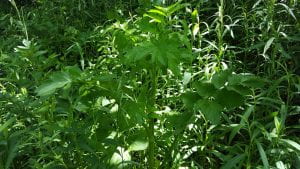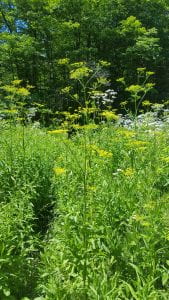“As everyone knows, when fighting a zombie, you grab a shovel and aim for its head. The same with wild parsnip, except you aim for its feet.” – Paul Hetzler

There is no lack of invasive species in New York – but some do raise more of a concern than others. One such is the wild parsnip. In a few weeks it will proclaim itself with its wide, yellow flower cluster. But it is currently a few feet tall and whether it is bedecked with flowers or not, its sap is just as risky. So if your weekend plans involves weed whacking, beware!

According to the New York Invasive Species Information Clearinghouse, wild parsnip produces furanocoumarin, “a compound in its leaves, stems, flowers, and fruits, that causes intense, localized burning, rash, severe blistering, and discoloration on contact with the skin on sunny days”. Avoid the sap and avoid the chemical burns.
Digging out the root, mowing, and herbicides can be effective in managing wild parsnip, with the caveat that you protect yourself from any and all contact with the sap.
If you want to learn more about wild parsnip and its management, our favorite guest blogger Paul Hetzler covered it well and humorously in his blog, Vengeful Veggies.
For more pictures of wild parnsip, visit the Turfgrass and Landscape Weed ID website. For information on other invasive species, visit the New York State IPM Program’s Invasive Species page.